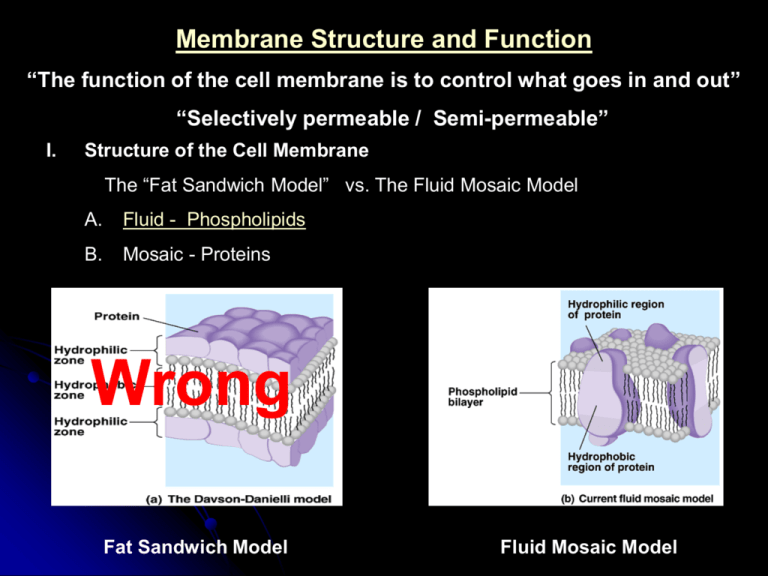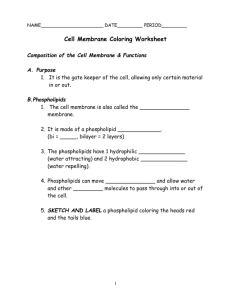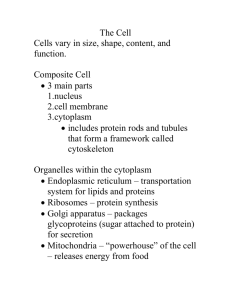Structure of the Cell Membrane
advertisement

Membrane Structure and Function “The function of the cell membrane is to control what goes in and out” “Selectively permeable / Semi-permeable” I. Structure of the Cell Membrane The “Fat Sandwich Model” vs. The Fluid Mosaic Model A. Fluid - Phospholipids B. Mosaic - Proteins Wrong Fat Sandwich Model Fluid Mosaic Model ExtraCellular Face Cytoplasmic Face Functions: 1. Phospholipid - Hydrophilic head, polar, interacts 2. Phospholipid – Hydrophobic tail, nonpolar, separates 3. Cholesterol : Maintains Fluidity at different temperatures Transport Intracellular joining Enzymes Cell-cell recognition 4. Glycolipids / Glycoprotein / Carbohydrates Cell Markers, ID’s, Recognition, Communication 5. Peripheral Proteins: Cytoskeleton attachment 6. Integral Proteins Many Functions Signal transduction Attachment II. Molecules can pass through Membranes if: A. Small enough Example: Fast - O2, CO2, H2O Slow - C6H12O6 Can’t – polypetides (proteins) polysaccarides (starches) B. Non-Polar enough Example: O2, CO2, Steroids, Lipids Note: Ions do not move through membranes very well (Na+, Cl-, H+, ) due hydration shell C. Concentrated enough Example: H2O, All living things are 70-80% water D. Helped by Transport Proteins Enough Transport Proteins provide unique environments in the membrane to allow passage of specific molecules E. Any combination of the above Example - Water III. What energy “makes" molecules move through membranes? A. Molecular motion (Kinetic Energy) Diffusion 1. Definition: Movement of molecules from a high concentration to a low concentration 2. Characteristics a. Follows a concentration gradient b. Does not require additional energy c. “Passive Transport” 3. How cell uses diffusion Environment High Oxygen Cell Cell Respiration Low Carbon Dioxide IV. Osmosis The Special Case of Water A. Definition: The diffusion of water across a semi-permeable membrane B. Why does water have its own unique word to describe how it diffuses? 1. All organism are 70-80% water - The highest of all concentration gradients 2. Membranes are completely permeable to water (The membrane can not “just say no”) Environment Cell Environment H2O – 98% DS -- 2% Cell H2O – 90% Cell Environment Cell H2O – 98% Cell DS -- 10% Cell DS -- 2% Water Flow H2O – 80% Tonicity DS -- 20% H2O – 95% Tonicity DS -- 5% Environment: Hypotonic Environment: Hypertonic Cell: Hypertonic Cell: Hypotonic H2O – 98% Tonicity DS -- 2% Isotonic Jargon Plant: Turgor Pressure Plasmolysis Flaccid Animal: Cytolysis Crenation Osmotic Balance “Hydrostatic Skeleton” Summary LAB DATA Elodea in Freshwater Elodea in Salt and/or Glucose Elodea in Acetone V. Facilitated Diffusion A. Definition: Movement of specific molecules from a high to a low concentration with the help of specific transport proteins B. Characteristics of transport protein 1. No Extra energy requirement High Low gradient 2. Can change shape 3. Shape change may open or close channels 4. Works like an enzyme Examples: Ion Channels, Glucose transport, Aquaporins Glucose Insulin Ion Channel Transport Glucose Transport Transport Protein Inside Cell Open Channel VI. Active Transport - Moving Molecules against the Gradient A. Characteristics 1. Requires ATP 2. Moves molecules from Low to High concentration 3. Requires specific transport proteins B. Active Transport of Small Molecules 1. Usually involves the transport of Ions (why?) 2. Examples a) Sodium potassium pump How the pump actually works b) Proton (Hydrogen) pump Electrogenic pumps c) Co-Transport pumps - Active transport of H+ coupled with the passive transport of a different molecule C. Active Transport of Large Molecules (Bulk Transport) -All require fusion of membranes 1. Exocytosis - Bulk transport outside the cell a) Golgi Body Secretions b) Contractile Vacuoles “The Protozoan Sump Pump” Cell 80% H20 Environment 99% H20 Contractile Vacuole H20 H20 Paramecium Active transport of water to the outside of the cell 2. Endocytosis a) Phagocytosis “Cell Eating” Cell engulfs particle by wrapping pseudopodia (false feet) around the particle Food particle becomes a food vacuole to be digested by lysosome Amoebas White Blood Cells b) Pinocytosis “Cell Drinking” Small pockets in cell membrane pinches off and pulls in extra-cellular fluids c) Receptor Mediated Endocytosis Membrane bound protein receptor sites bind to specific “ligands” outside of cell Receptors accumulate in a membrane “pit” and are then pulled in by pinocytosis (Summary) A Small Phospholipid Drop In Water “Miscelle” “Amphipathic Molecule” Phospholipid bilayer forms when larger quantities are immersed in water Slide 2 Proton Pump Slide 10 Proton Pump (active transport) coupled with a cotransport protein (passive) Slide 10 Slide 2 Proof of the Fluidity of Membranes Movement of Phospholipids Flip-flop rare Lateral movement common Factors Determining Membrane Fluidity Unsaturated Saturated (Plants) (Less Dense) (Animals) (More Dense) How do animals maintain membrane fluidity? Cholesterol Slows phospholipid movement at higher temperatures yet hinders solidification at lower temperatures Fluid Viscous Slide 2 Phagocytosis Pinocytosis Receptor Mediated Endocytosis Slide 9 Slide 1 “Porin” an Example of a Transport Channel Slide 3 Slide 8 Slide 9 Slide 9 Receptor-mediated Endocytosis (pinocytosis) Slide 9 Slide 5 Aquaporins – Protein Water Channels Water molecules outside cell Cell Membrane Water molecules inside cell Aquaporin I Aquaporin II Slide 8 The Sodium Potassium Pump in Action Inside the Cell Outside the Cell Slide 10






